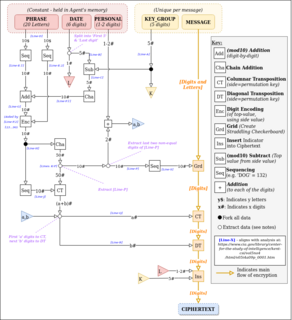In cryptography, a keystream is a stream of random or pseudorandom characters that are combined with a plaintext message to produce an encrypted message (the ciphertext).
The "characters" in the keystream can be bits, bytes, numbers or actual characters like A-Z depending on the usage case.
Usually each character in the keystream is either added, subtracted or XORed with a character in the plaintext to produce the ciphertext, using modular arithmetic.
Keystreams are used in the one-time pad cipher and in most stream ciphers. Block ciphers can also be used to produce keystreams. For instance, CTR mode is a block mode that makes a block cipher produce a keystream and thus turns the block cipher into a stream cipher.
BlockBlock cryptography, a block cipher is a deterministic algorithm operating on fixed-length groups of bits, called blocks. It uses an unvarying transformation, that is, it uses a block. They are specified elementary components in the design of many cryptographic protocols and are widely used to implement the encryption of large amounts of data, including data exchange protocols.

In cryptography, a cipher is an algorithm for performing encryption or decryption—a series of well-defined steps that can be followed as a procedure. An alternative, less common term is encipherment. To encipher or encode is to convert information into cipher or code. In common parlance, "cipher" is synonymous with "code", as they are both a set of steps that encrypt a message; however, the concepts are distinct in cryptography, especially classical cryptography.

In cryptography, the one-time pad (OTP) is an encryption technique that cannot be cracked, but requires the use of a single-use pre-shared key that is no smaller than the message being sent. In this technique, a plaintext is paired with a random secret key. Then, each bit or character of the plaintext is encrypted by combining it with the corresponding bit or character from the pad using modular addition.

A stream cipher is a symmetric key cipher where plaintext digits are combined with a pseudorandom cipher digit stream (keystream). In a stream cipher, each plaintext digit is encrypted one at a time with the corresponding digit of the keystream, to give a digit of the ciphertext stream. Since encryption of each digit is dependent on the current state of the cipher, it is also known as state cipher. In practice, a digit is typically a bit and the combining operation is an exclusive-or (XOR).
Symmetric-key algorithms are algorithms for cryptography that use the same cryptographic keys for both the encryption of plaintext and the decryption of ciphertext. The keys may be identical, or there may be a simple transformation to go between the two keys. The keys, in practice, represent a shared secret between two or more parties that can be used to maintain a private information link. The requirement that both parties have access to the secret key is one of the main drawbacks of symmetric-key encryption, in comparison to public-key encryption.

The Vigenère cipher is a method of encrypting alphabetic text by using a series of interwoven Caesar ciphers, based on the letters of a keyword. It employs a form of polyalphabetic substitution.
In cryptography, an initialization vector (IV) or starting variable (SV) is an input to a cryptographic primitive being used to provide the initial state. The IV is typically required to be random or pseudorandom, but sometimes an IV only needs to be unpredictable or unique. Randomization is crucial for some encryption schemes to achieve semantic security, a property whereby repeated usage of the scheme under the same key does not allow an attacker to infer relationships between segments of the encrypted message. For block ciphers, the use of an IV is described by the modes of operation.

An autokey cipher is a cipher that incorporates the message into the key. The key is generated from the message in some automated fashion, sometimes by selecting certain letters from the text or, more commonly, by adding a short primer key to the front of the message.
In cryptography, a block cipher mode of operation is an algorithm that uses a block cipher to provide information security such as confidentiality or authenticity. A block cipher by itself is only suitable for the secure cryptographic transformation of one fixed-length group of bits called a block. A mode of operation describes how to repeatedly apply a cipher's single-block operation to securely transform amounts of data larger than a block.

The VIC cipher was a pencil and paper cipher used by the Soviet spy Reino Häyhänen, codenamed "VICTOR".
In classical cryptography, the running key cipher is a type of polyalphabetic substitution cipher in which a text, typically from a book, is used to provide a very long keystream. Usually, the book to be used would be agreed ahead of time, while the passage to be used would be chosen randomly for each message and secretly indicated somewhere in the message.
The affine cipher is a type of monoalphabetic substitution cipher, where each letter in an alphabet is mapped to its numeric equivalent, encrypted using a simple mathematical function, and converted back to a letter. The formula used means that each letter encrypts to one other letter, and back again, meaning the cipher is essentially a standard substitution cipher with a rule governing which letter goes to which. As such, it has the weaknesses of all substitution ciphers. Each letter is enciphered with the function (ax + b) mod 26, where b is the magnitude of the shift.
Gilbert Sandford Vernam was a Worcester Polytechnic Institute 1914 graduate and AT&T Bell Labs engineer who, in 1917, invented an additive polyalphabetic stream cipher and later co-invented an automated one-time pad cipher. Vernam proposed a teleprinter cipher in which a previously prepared key, kept on paper tape, is combined character by character with the plaintext message to produce the ciphertext. To decipher the ciphertext, the same key would be again combined character by character, producing the plaintext. Vernam later worked for the Postal Telegraph Company, and became an employee of Western Union when that company acquired Postal in 1943. His later work was largely with automatic switching systems for telegraph networks.
CipherSaber is a simple symmetric encryption protocol based on the RC4 stream cipher. Its goals are both technical and political: it gives reasonably strong protection of message confidentiality, yet it's designed to be simple enough that even novice programmers can memorize the algorithm and implement it from scratch. According to the designer, a CipherSaber version in the QBASIC programming language takes just sixteen lines of code. Its political aspect is that because it's so simple, it can be reimplemented anywhere at any time, and so it provides a way for users to communicate privately even if government or other controls make distribution of normal cryptographic software completely impossible.
In cryptography, ciphertext stealing (CTS) is a general method of using a block cipher mode of operation that allows for processing of messages that are not evenly divisible into blocks without resulting in any expansion of the ciphertext, at the cost of slightly increased complexity.
The Solitaire cryptographic algorithm was designed by Bruce Schneier at the request of Neal Stephenson for use in his novel Cryptonomicon, in which field agents use it to communicate securely without having to rely on electronics or having to carry incriminating tools. It was designed to be a manual cryptosystem calculated with an ordinary deck of playing cards. In Cryptonomicon, this algorithm was originally called Pontifex to hide the fact that it involved playing cards.
In cryptography, M8 is a block cipher designed by Hitachi in 1999. The algorithm negotiates introduced in 1997 M6, with the modified key length, which is enlarged to 64 bits or more. This cipher operates with Feistel network and designed to reach high performance on small implementation or 32 bits devices. For instance, by using round numbers = 10 it present encryption speed at 32 Mbit/s for dedicated hardware of 6K gates and 25 MHz clock or 208 Mbit/s for program, that uses C-language and Pentium-I 266 MHz. Due to the openness of description, it should not be used in open or multivendor software.
In cryptography, a distinguishing attack is any form of cryptanalysis on data encrypted by a cipher that allows an attacker to distinguish the encrypted data from random data. Modern symmetric-key ciphers are specifically designed to be immune to such an attack. In other words, modern encryption schemes are pseudorandom permutations and are designed to have ciphertext indistinguishability. If an algorithm is found that can distinguish the output from random faster than a brute force search, then that is considered a break of the cipher.

In cryptography key feedback mode (KFB) is a mode of operation for cryptographic block ciphers. It uses the block cipher output block to form the block cipher key of the next round, thereby creating a keystream generator that can be used as a synchronous stream cipher.
In cryptography, format-preserving encryption (FPE), refers to encrypting in such a way that the output is in the same format as the input. The meaning of "format" varies. Typically only finite sets of characters are used; numeric, alphabetic or alphanumeric. For example:






